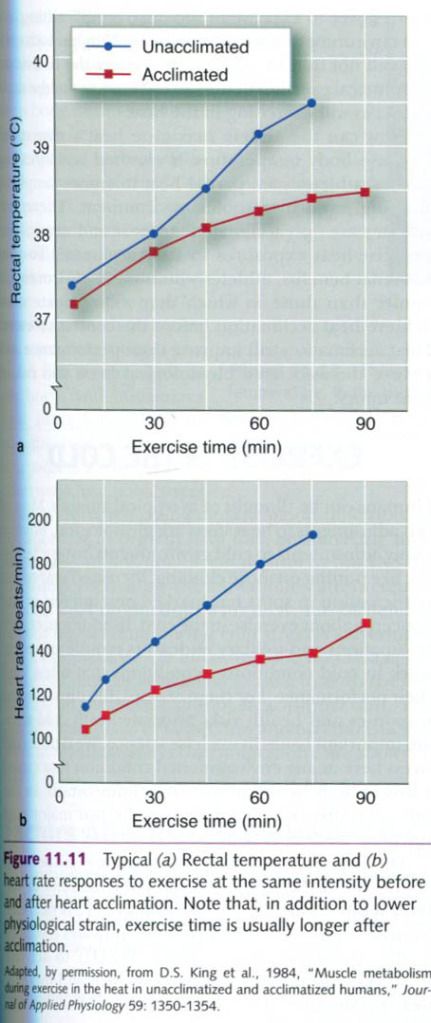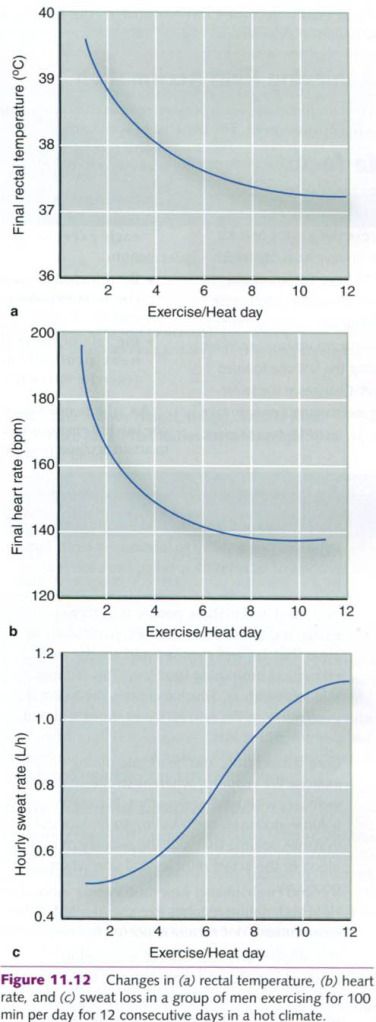Effects of heat acclimation
Repeated bouts of prolonged, low-intensity
exercise in the heat cause a relatively rapid improvement in the ability to
eliminate excess body heat, which reduces psychological strain. This process,
termed heat acclimation, results in
psychological adjustments in plasma volume, cardiovascular function, sweating,
and skin blood flow that allow for subsequent exercise bouts in the heat to be
performed with a lower core temperature and heart rate response. Because the
body’s heat loss capacity at a given rate of work is enhanced by acclimation,
core temperatures during exercise increase less than before acclimation(picture
a), and heart rate increases less in
response to standardized submaximal exercise after heat acclimation(picture b).
In addition, after heat acclimation, more work can be done before the onset of
fatique or exhaustion.
The sequence of positive adaptations takes a
period of 9 to 14 days of exercise in the heat to fully occur, as shown in the
figure below. Well-trained individuals need fewer exposures than untrained
individuals to fully acclimate. A critical physiological adjustment that occurs
over the first one to three days of acclimation is the expansion of plasma
volume. The exact mechanism by which plasma volume expands after these initial
exercise-heat exposures is not universally agreed upon. The process likely
involves: 1) proteins being forced
out of the circulation as muscles contract, 2) these same proteins then being
returned to the blood through the
lymph, and 3) fluid moving into the blood
because of the oncotic pressure exerted by the increased protein content. However, this change is temporary, and blood volume usually returns to original
levels within 10 days. This early expansion of blood volume is important because it supports stroke volume, allowing the body to maintain cardiac output while additional physiological adjustments are made.
As shown in the figure above, as gradual
acclimation allows heart rate and core temperature to decrease, sweat rate
during exercise in the heat increases with heat acclimation. Additionally, the
amount of sweat produced often increases on the most exposed body areas such as
the arms and legs, the areas that are most effective in dissipating body heat.
At the beginning of exercise, sweating starts earlier in an acclimated person,
which improves heat tolerance; and the sweat that is produced becomes more
dilute, conserving sodium. This latter effect occurs in part because the
eccrine sweat glands become more sensitive to the effects of circulating aldosterone.
Achieving heat acclimation
Heat acclimation requires more than merely
resting in a hot environment. The benefits of acclimation, as well as the
rate at which we acclimate, depend on:
- The environmental conditions
during each exercise session;
- The duration of
exercise-heat exposure, and
- The rate of internal heat
production(exercise intensity).
An athlete must exercise in a hot environment
to attain acclimation that carries over to exercise in the heat. Simply sitting
in a hot environment, such as a sauna, for long periods each day will not fully
or adequately prepare the individual for physical exertion in the heat, at
least not to the same extent as will exercising in the heat.
How can athlete maximize heat acclimation?
Because body temperature is elevated and sweating occurs, athletes gain partial
heat tolerance simply by training, even in a cooler environment. Therefore,
athletes are “preacclimated” to heat and need fewer exercise-heat exposures to
fully acclimate. To gain maximal benefits, athletes who train in environments
cooler than those in which they will compete must achieve heat acclimation
before the contest or event. Heat acclimation will improve their performance
and reduce the associated physiological stress and risk of heat injury.











0 коментара:
Постави коментар